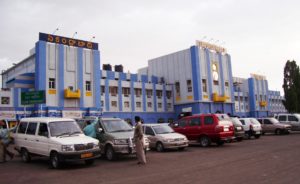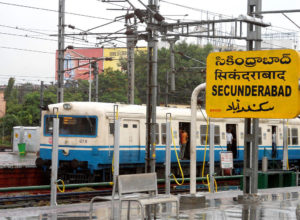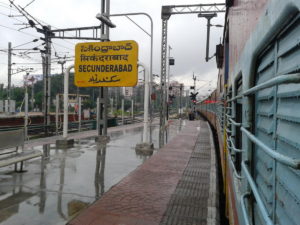 Secunderabad railway station, is a major intercity railway station and a commuter rail hub in the Hyderabad Urban Area. It is located in the city of Hyderabad and falls under the South Central Railway zone of Indian Railways. Built in 1874, by the Nizam of Hyderabad State, during the British era, this station was the main station of the Nizam’s Railway, until the opening of Kachiguda Railway Station in 1916. Later on, its operation was taken over by the Indian Railways in 1951, when the Nizam’s Railway was nationalized. The main portico and concourse are influenced by Asaf Jahi style architecture. The station building resembles a fort and is one of the tourist attractions in the twin cities of Hyderabad and Secunderabad.
Secunderabad railway station, is a major intercity railway station and a commuter rail hub in the Hyderabad Urban Area. It is located in the city of Hyderabad and falls under the South Central Railway zone of Indian Railways. Built in 1874, by the Nizam of Hyderabad State, during the British era, this station was the main station of the Nizam’s Railway, until the opening of Kachiguda Railway Station in 1916. Later on, its operation was taken over by the Indian Railways in 1951, when the Nizam’s Railway was nationalized. The main portico and concourse are influenced by Asaf Jahi style architecture. The station building resembles a fort and is one of the tourist attractions in the twin cities of Hyderabad and Secunderabad.
The station is well connected by rail to all parts of India. 229 trains arrive at, or depart from, the station, daily, transporting over one lakh sixty thousand (160,000) passengers daily to their destinations across the country. Situated on the Vijayawada – Wadi (main line of SCR) and Secunderabad-Manmad railway lines, it is the zonal headquarters station of the South Central Railway (SCR), and also the divisional headquarters station of Secunderabad Division of the SCR. The station has also achieved the ISO-9001 Certification for quality management in ticket booking, parcel and luggage booking and train management of platform.
The Rajdhani Express which connects the state capitals of India with the National Capital of India was proposed in Andhra Pradesh between Secunderabad and the Hazrat Nizamuddin Railway Station in the 2001 Indian Rail Budget. The Secunderabad Rajdhani Express was introduced on 27 February 2002. The Hyderabad Multi-Modal Transport System (MMTS), the first of its kind in Andhra Pradesh, was introduced in 2003 with two lines: Lingampally – Hyderabad Railway Station with 13 services, and Lingampally Railway Station – Secunderabad with 11 services each day (initially). Another line was constructed between Se cunderabad and Falaknuma Railway Station. On 30 June 2004 the SCR operated the last metre gauge train on the Nizamabad–Manoharabad line bringing to an end the metre gauge services which started in the 1930s on the Secunderabad–Manmad line of the Nizam’s State Railways (formerly Hyderabad-Godavari Valley Railways). This was to facilitate the conversion of the track to broad gauge under the Project Unigauge program of Indian Railways. This line was open to traffic by 7 February 2005 after its conversion to broad gauge, allowing railway traffic on the Secunderabad–Manmad stretch of the Kachiguda Railway Station – Manmad line
cunderabad and Falaknuma Railway Station. On 30 June 2004 the SCR operated the last metre gauge train on the Nizamabad–Manoharabad line bringing to an end the metre gauge services which started in the 1930s on the Secunderabad–Manmad line of the Nizam’s State Railways (formerly Hyderabad-Godavari Valley Railways). This was to facilitate the conversion of the track to broad gauge under the Project Unigauge program of Indian Railways. This line was open to traffic by 7 February 2005 after its conversion to broad gauge, allowing railway traffic on the Secunderabad–Manmad stretch of the Kachiguda Railway Station – Manmad line
Notification For Secunderabad
Secunderabad Railway Station (Central Station) is one of the biggest and busiest railway stations in the Indian railway system. It is the main railway terminus and a major commuter hub in the Hyderabad Urban Area which is the capital of Telangana state, the main one of the three major railway stations serving the city, the other two being Kachiguda Railway Station and Deccan-Nampalli Railway Station.
It is the zonal headquarters of South Central Railway and the divisional headquarters of the Secunderabad Division. Secunderabad Railway Station is the busiest station after Vijayawada Junction Station. And the third biggest junction in SCR after Vijayawada and Guntakal junctions. To reduce the railway traffic at Secunderabad railway station the Railway Board had decided on a fourth main station for Hyderabad to regulate the increasing passenger traffic at Secunderabad. There are two proposals for the new terminal, Malkajgiri Railway Station and Moulali Railway Station.
 The station has 10 platforms which are covered by an R.C.C (Reinforced Cement Concrete) roof. Each platform can handle a train with more than 24 coaches. All the tracks are broad gauged and there is an additional track between platform no’s. 7 & 8 i.e. 6A,6B,7A,7B which is a service track for the MMTS and suburban trains where two trains halt at the same platform (due to their short length). Platform Nos. 6 & 7 are each divided into two as 6A, 6B and 7A, 7B
The station has 10 platforms which are covered by an R.C.C (Reinforced Cement Concrete) roof. Each platform can handle a train with more than 24 coaches. All the tracks are broad gauged and there is an additional track between platform no’s. 7 & 8 i.e. 6A,6B,7A,7B which is a service track for the MMTS and suburban trains where two trains halt at the same platform (due to their short length). Platform Nos. 6 & 7 are each divided into two as 6A, 6B and 7A, 7B
How to Apply to Secunderabad
The proposal for constructing Secunderabad Railway Station was raised in 1870 when the Nizam of Hyderabad State decided to connect the state with the rest of Indian sub-continent. The Nizam’s Railways was formed as a private company and construction of the Secunderabad-Wadi line started in the same year. This line would connect Hyderabad with the Great Indian Peninsular Railway’s (the railway company owned by the British India) main line at Wadi Junction. The Nizam provided all the expenses for the construction.
The Hyderabad-Godavari Valley Railway Company was established in 1900 with the opening of the Manmad-Secunderabad metre gauge line. However, the company eventually merged into Nizam’s State Railways in 1930. In 1916 another railway terminus, Kachiguda Railway Station, was constructed as the headquarters of Nizam’s Guaranteed State Railway and also to regulate the traffic at Secunderabad. Diesel rail cars by Ganz were tried out for the first time in Hyderabad State, by Nizam’s State Railway, in 1939
Vacancy Notification Secunderabad
The Secunderabad–Mahbubnagar metre gauge section was converted to broad gauge in 1993, breaking one of the important north-south meter gauge freight connections in India towards the north from Secunderabad. The same year the Secunderabad Station was electrified towards Kazipet and Vijayawada Junction. The electric locomotive shed in South Lallaguda (near Secunderabad Station), with a capacity to maintain 100 electric locomotives, was built in 1995
